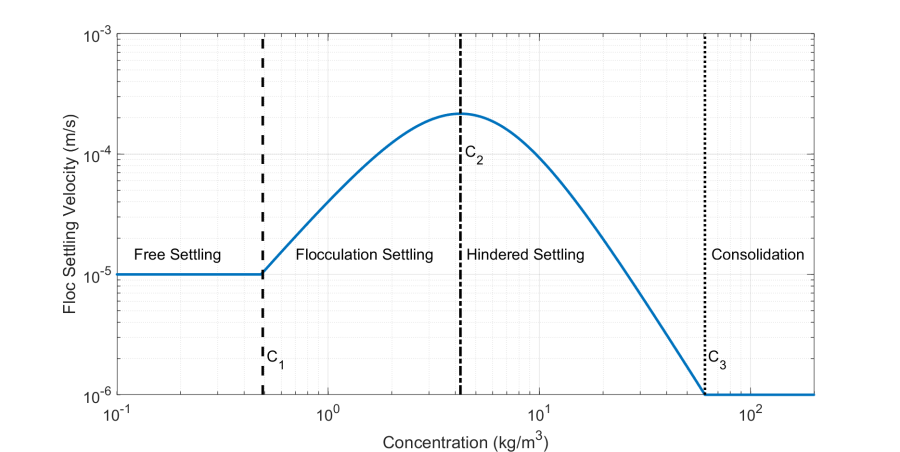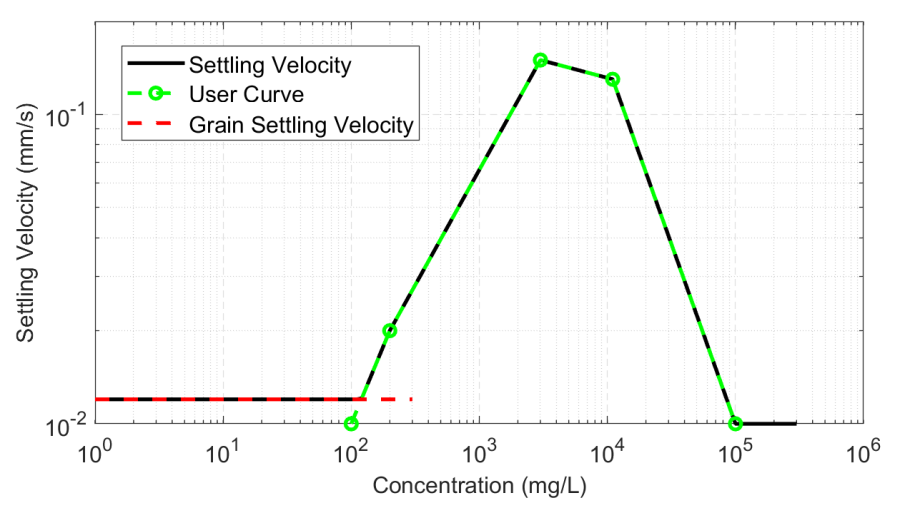Download PDF
Download page Fall Velocity of Cohesives.
Fall Velocity of Cohesives
Cohesive particles may settle in the form of particles, flocs and/or aggregates. Generally, flocculation is negligible for sediment particles larger than 0.03 mm (see Migniot 1968). The flocculation of particles is affected by the sediment size and concentration, water salinity, temperature, and turbulence intensity, and among others. The settling velocity of flocs can be several orders of magnitude larger than that of the dispersed sediment particles it is important to consider the sediment velocity of flocs. However, the flocculation process is very complicated as it is a function of the sediment concentration, particle sizes, turbulence, water temperature, salinity, pH, etc. At present, the Hwang (1989) floc settling velocity formulation is implemented as well as a user-specified concentration versus settling curve. These two methods compute the floc settling velocity as a function of concentration. It is also important to mention that there are a wide range of settling velocities for a given concentration, and the settling velocity utilized represents an average settling velocity of all the particles and flocs for a given concentration. The floc settling velocity is corrected for water temperature by assuming the fall velocities are inversely proportional to the dynamic viscosity (see Wu 2007). Other factors such as salinity and turbulence are presently not accounted for the floc settling velocities. Currently, the settling velocity of aggregates is not considered. The only way aggregates can be modeled currently is by assuming they are conservative particles which are not created or destroyed and computing their settling velocity utilizing one of the particle settling velocity formulas described above.
Hwang
The Hwang (1989) floc settling formula is based on Wolanski et al. (1989) may be written as
| 1) | \omega _{sf}=\left\{\begin{array}{l} \omega _{sk}\,\,\,\,\,\,\,\,\,\,\,\,\,\,\,\,\,\,\,\,\,\,\,\,\mathrm{for}\,C\leq C_{1}\\ a\frac{C^{n}}{(C^{2}+b^{2})^{m}}\,\,\,\,\,\mathrm{for}\,C_{1}<C\leq C_{3}\\ \omega _{s3}\,\,\,\,\,\,\,\,\,\,\,\,\,\,\,\,\,\,\,\,\,\,\,\,\,\mathrm{for}\,C>C_{3} \end{array}\right. |
where
ωsf = median floc settling velocity [m/s]
ωsk = dispersed particle settling velocity [m/s]
ωs3 = settling velocity corresponding to C3 [m/s]
C = suspended sediment concentration [kg/m3]
C1 = free settling upper concentration limit (~0.1 0.3) [kg/m3]
C2= flocculation settling upper concentration limit (~4 kg/m3) [kg/m3]
C3= hindered settling upper concentration limit (~75 kg/m3) [kg/m3]
a = empirical coefficient between 0.01 and 0.23 [m/s]
b = empirical coefficient between 1.3 and 25.0 [kg/m3]
m = empirical exponent between 1.0 and 2.8
n = empirical exponent between 0.4 and 2.8
A representative settling velocity curve for a silt particle as a function of total sediment concentration is shown in the figure below. The settling velocity has four distinct zones. At low concentrations, flocculation is negligible, and particles settle freely. At a certain concentration, C1, flocculation settling occurs and the settling velocity increases with sediment concentration as more and more flocs are formed. At a certain concentration, C2, the setting velocity reaches a maximum value and begins to decrease as the concentration decreases due to hindered settling.

Figure 2 18. Flow settling velocity following Hwang (1989).
User-Defined Table
The simplest option for specifying the settling velocity of cohesives is a user-defined curve. Below is an example of the fall velocity for cohesives as a function of the sediment concentration. If the concentration goes beyond the curve, then the nearest point is utilized. The settling velocity is interpolated in log-space. 
Figure 2 19. Example user-specified floc settling velocity curve (green dashed line with circle markers), grain-settling velocity (dashed red line) computed settling velocity as a function of concentration (black solid line).
When the settling velocities are less than the particle velocities and the concentration is less that the concentration corresponding to the maximum settling velocity, the settling velocity is set to the particle velocity.
Temperature Correction
The floc settling velocity obtained from the Hwang or user-defined curve are assumed to be at a water temperature 55.4∘F. If the water temperature is changes, the floc settling velocity from the Hwang and user-defined curves is corrected as the ratio (Wu 2007)
| 2) | \frac{\omega _{sf,T}}{\omega _{sf,R}}=\frac{\mu _{w,R}}{\mu _{w,T}} |
where μw, R and μw, T are the dynamic viscosities at the reference and actual water temperatures respectively. Similarly ωsf, R and ωsf, T are the floc settling velocities at the reference and actual water temperatures, respectively.